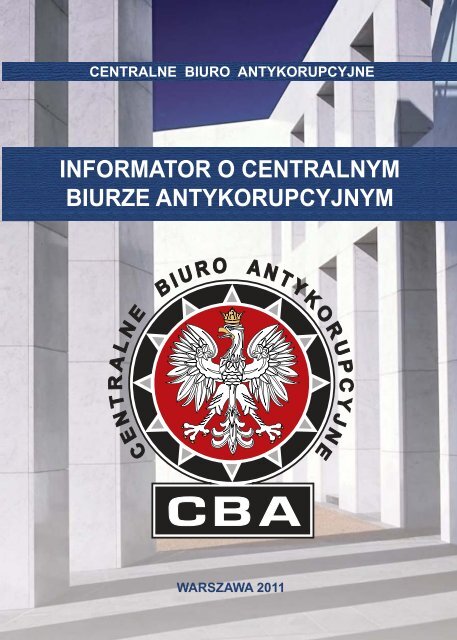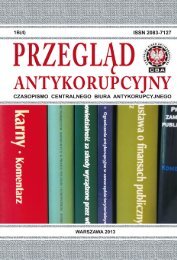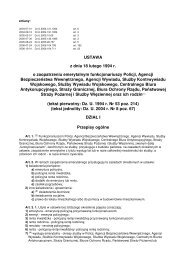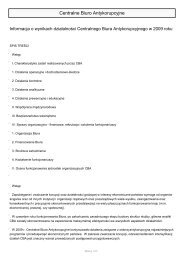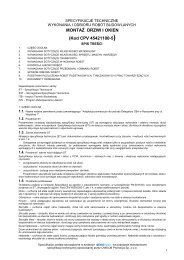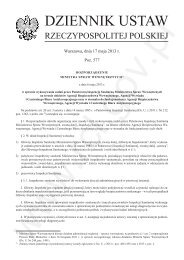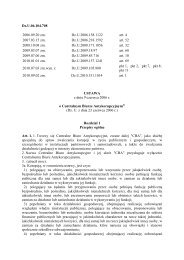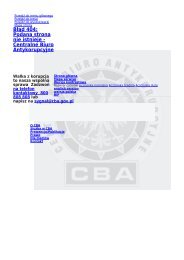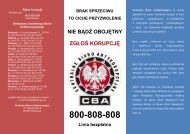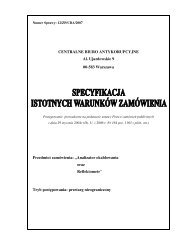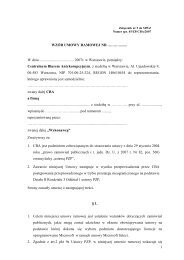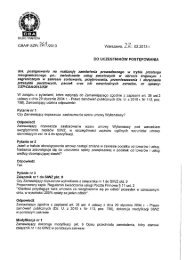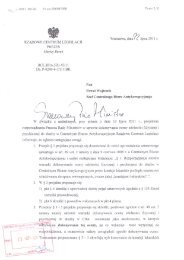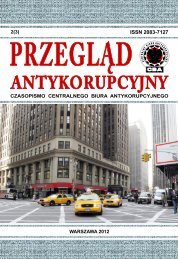mnt A5.indd - Centralne Biuro Antykorupcyjne
mnt A5.indd - Centralne Biuro Antykorupcyjne
mnt A5.indd - Centralne Biuro Antykorupcyjne
Create successful ePaper yourself
Turn your PDF publications into a flip-book with our unique Google optimized e-Paper software.
INFORMATOR O CENTRALNYMBIURZE ANTYKORUPCYJNYM
Dziaalno edukacyjna CBA pozwolia na wydanie nastpujcych publikacji (dostpnych nahttp://antykorupcja.edu.pl oraz http://cba.gov.pl):Podrcznik antykorupcyjny dla urzdnikówPublikacja adresowana jest przede wszystkim do osób pracujcychw administracji pastwowej i samorzdowej. Podrcznik przedstawiapodstawowe pojcia korupcyjne. Wskazuje rónice pomidzyfunkcjonariuszem publicznym a osob penic funkcj publicznoraz wyjania, co to jest korzy majtkowa, a co rozumiemypod pojciem korzyci osobistej. Wszyscy urzdnicy po lekturzepodrcznika powinni wiedzie, jak naley postpowa w sytuacji,gdy otrzymuj propozycj korupcyjn – co w takim momencie powinni zrobi, a czegorobi nie mog.Rekomendacje postpowa antykorupcyjnych przy stosowaniu procedury udzielaniazamówie publicznych<strong>Centralne</strong> <strong>Biuro</strong> <strong>Antykorupcyjne</strong> zwraca uwag na mogce pojawi sinieprawidowoci w wydatkowaniu rodków publicznych w tokurealizacji zakupu usug lub dostaw, a take procedur inwestycyjnych.Niniejsze rekomendacje maj na celu przyblienie procesu udzielaniazamówie publicznych oraz udzielenie wsparcia kierownikomjednostek zamawiajcych w prowadzeniu postpowa o udzieleniezamówie publicznych poprzez wskazanie czsto pojawiajcychsi nieprawidowoci oraz sposobów im zapobiegania. Opisane przykady mog pozytywniewpyn na realizacj procesu udzielenia zamówienia publicznego, a tym samym znaczniezwikszy szanse zamawiajcego na zakoczenie postpowania o udzielenie zamówieniapublicznego z podanym skutkiem.
Mapa korupcjiDane i informacje uzyskane od sub i instytucji zostayusystematyzowane w trzech blokach tematycznych. W pierwszymzostay wskazane i omówione obszary szczególnie zagroone korupcj.Zaprezentowano równie mechanizmy popeniania przestpstwkorupcyjnych. Drugi rozdzia powicono danym statystycznymdotyczcym stwierdzonych przestpstw korupcyjnych oraz wstpnejcharakterystyce sprawców przestpstw korupcyjnych. Trzeci rozdziaopracowania dotyczy spoecznego odbioru zjawiska korupcji. Przedstawiono w nim szerokiespektrum przeprowadzonych w cigu ostatnich kilkunastu lat bada sondaowychdotyczcych korupcji. Ostatni czci publikacji jest podsumowanie, w którym zostayomówione przyczyny oraz skutki wystpowania korupcji, a take problemyz diagnozowaniem zjawiska i szacowaniem jego skali.Instytucje antykorupcyjne w wybranych pastwach wiataJest to zbiór informacji na temat rozwiza instytucjonalnychi systemowych stosowanych w innych krajach. Wskazane w publikacjiorgany zwalczajce korupcj obejmuj zarówno wyspecjalizowaneagencje, jak i instytucje, dla których walka z korupcj jest tylko jednymz zada naoonych przez ustawodawc oraz takie, które walkz korupcj prowadz wspólnie z innymi organami ochrony prawa.Wspópraca midzynarodowaCBA wspódziaa w zakresie swojej waciwoci z organizacjami midzynarodowymi,swoimi odpowiednikami i organami cigania innych pastw na podstawie umówi porozumie midzynarodowych oraz odrbnych przepisów. CBA wspópracuje, midzyinnymi, z OLAF (Europejskim Urzdem ds. Zwalczania Oszustw), Interpol, Europol, EPAC(Europejskimi Partnerami Przeciwko Korupcji)/EACN (Europejsk Sieci Antykorupcyjn)oraz z oficerami cznikowymi organów cigania akredytowanymi w RP .
Ponadto przygotowano oraz przeprowadzono szereg spotka i prezentacji dla delegacjizagranicznych, w tym dla uczestników Projektu Zwalczania Prania oraz delegacjiparlamentarnych, samorzdowców oraz przedstawicieli organów cigania innych pastw.Jedn z inicjatyw CBA jest przyjmowanie przedstawicieli organów cigania, realizujcychwizyty studyjne w ramach projektów finansowanych przez Uni Europejsk..Funkcjonariusze CBA uczestniczyli take w przygotowaniu projektów o zasigumidzynarodowym, np. projektu bliniaczego dla Rumunii Transition Facility „Zwalczanieprania pienidzy i finansowania terroryzmu” realizowanego przez Ministerstwo Finansów RP,gdzie równie podejmowano w ramach wizyty przedstawicieli beneficjenta projektu. CBAprezentowao dowiadczenia antykorupcyjne w Polsce w ramach programu budowaniawiadomoci antykorupcyjnej, realizowanego przez Departament Sprawiedliwoci USA,skierowany do przedstawicieli ukraiskich organów cigania. <strong>Centralne</strong> <strong>Biuro</strong> <strong>Antykorupcyjne</strong>uczestniczyo w unijnym projekcie bliniaczym Transition Facility 2005 i 2006 (Intensyfikacjaprocesu wdraania dziaa antykorupcyjnych w Polsce), penic rol gównego beneficjenta.Efektem wspópracy z ekspertami niemieckimi, belgijskimi i holenderskimi by cyklwszechstronnych szkole, stay i warsztatów dla funkcjonariuszy CBA, zrealizowanychw Polsce i w krajach partnerskich sub, jak równie wydanie podrcznika „Europa bezkorupcji. Studium przypadków. Kazusy polsko-niemiecko-belgijskie.”.Kadra CBACBA zatrudnia okoo 850 funkcjonariuszy i pracowników, którzy s wysokiej klasyprofesjonalistami w dziedzinach zwizanych z realizacj podstawowych zada suby orazdziaa zabezpieczajcych ich realizacj. S to specjalici z zakresu pracy operacyjnej,czynnoci dochodzeniowo-ledczych, analiz, czynnoci kontrolnych, bezporednich dziaaochronnych, budowania i bezpieczestwa sieci teleinformatycznych, ochrony informacjiniejawnych i danych osobowych, obsugi prawnej, logistyki i finansów, audytui bezpieczestwa wewntrznego, wspópracy midzynarodowej oraz zabezpieczeniai szkolenia kadr.
Struktura organizacyjna CBA
DANE ADRESOWE CENTRALNEGO BIURA ANTYKORUPCYJNEGO<strong>Centralne</strong> <strong>Biuro</strong> <strong>Antykorupcyjne</strong>Al. Ujazdowskie 900-583 Warszawaemail: bip@cba.gov.pltel. (22) 437 22 22fax: (22) 437 22 97<strong>Biuro</strong> Podawcze oraz <strong>Biuro</strong> Przepustek CBA znajduj si przy wejciu od Al. J.Ch. Szucha.CBA zastrzega sobie prawo do nieodpowiadania na wszystkie listy.Nabór do suby(22) 437 15 06Delegatury <strong>Centralne</strong>go Biura <strong>Antykorupcyjne</strong>goBiaystok, ul. Antoniukowska 21, 15-740 Biaystok, tel. (85) 876 30 00; (22) 437 30 00Gdask, ul. Kartuska 385 b, 80-125 Gdask, tel. (58) 767 31 00; (22) 437 31 00Katowice, ul. 1 Maja 123, 40-235 Katowice, tel. (32) 788 32 00; (22) 437 32 00Kraków, ul. Racawicka 58, 30-017 Kraków, tel. (12) 342 33 00; (22) 437 33 00Lublin, ul. Hempla 6, 20-008 Lublin, tel. (81) 461 34 00; (22) 437 34 00ód, ul. eromskiego 87, 90-502 ód, tel. (42) 239 35 00; (22) 437 35 00Pozna, ul. Wichrowa 20, 60-449 Pozna, tel. (61) 668 36 00; (22) 437 36 00Rzeszów, ul. Podwisocze 42, 35-309 Rzeszów, tel. (17) 784 37 00; (22) 437 37 00Szczecin, ul. Ku Socu 33a, 70-907 Szczecin, tel. (91) 889 26 02; (22) 437 38 00Warszawa, ul. Poleczki 3, 02-822 Warszawa, tel. 22 437 24 00Wrocaw, ul. Rodakowskiego 6, 51-637 Wrocaw, tel. (71) 757 39 50; (22) 437 39 50
ROZMIESZCZENIE DELEGATUR CBA
Zgo korupcjPAMITAJ!Nie podlega karze sprawca przestpstwa korupcyjnego,jeeli korzy majtkowa lub osobista albo ich obietnica zostaa przyjta bd wrczona,a sprawca zawiadomi o tym fakcie organ powoany do cigania przestpstwi ujawni wszystkie istotne okolicznoci przestpstwa -zanim organ ten o nim si dowiedzia.Bezpatny nr telefonu 800 808 808Zgo korupcj osobicie:ul.Poleczki 302-822 Warszawae-mail: kontakt@cba.gov.plRzecznik prasowyJacek Dobrzyskitel. (22) 437 22 11 (w godzinach 8.00-16.00)e-mail: media@cba.gov.plUWAGA:Rzecznik prasowy odpowiada na korespondencj elektroniczn pochodzc wycznie oddziennikarzy. Korespondencja powinna zawiera imi i nazwisko dziennikarza, redakcji numer telefonu. Pozostae listy bd przekazywane do innych komórek organizacyjnychCBA wedug waciwoci.
. . . . . . . . . . . . . . . . . . . . . . . . . . . . . . . . . . . . . . . . . . . . . . . . . . . . . . . . . . . . . . . . . . . . . . . . . . . . . . . . . . . . . . . . . . . . . . . . . . . . . . . . . . . . . . . . . . . . .. . . . . . . . . . . . . . . . . . . . . . . . . . . . . . . . . . . . . . . . . . . . . . . . . . . . . . . . . . . . . . . . . . . . . . . . . . . . . . . . . . . . . . . . . . . . . . . . . . . . . . . . . . . . . . . . . . . . .. . . . . . . . . . . . . . . . . . . . . . . . . . . . . . . . . . . . . . . . . . . . . . . . . . . . . . . . . . . . . . . . . . . . . . . . . . . . . . . . . . . . . . . . . . . . . . . . . . . . . . . . . . . . . . . . . . . . .. . . . . . . . . . . . . . . . . . . . . . . . . . . . . . . . . . . . . . . . . . . . . . . . . . . . . . . . . . . . . . . . . . . . . . . . . . . . . . . . . . . . . . . . . . . . . . . . . . . . . . . . . . . . . . . . . . . . .. . . . . . . . . . . . . . . . . . . . . . . . . . . . . . . . . . . . . . . . . . . . . . . . . . . . . . . . . . . . . . . . . . . . . . . . . . . . . . . . . . . . . . . . . . . . . . . . . . . . . . . . . . . . . . . . . . . . .. . . . . . . . . . . . . . . . . . . . . . . . . . . . . . . . . . . . . . . . . . . . . . . . . . . . . . . . . . . . . . . . . . . . . . . . . . . . . . . . . . . . . . . . . . . . . . . . . . . . . . . . . . . . . . . . . . . . .. . . . . . . . . . . . . . . . . . . . . . . . . . . . . . . . . . . . . . . . . . . . . . . . . . . . . . . . . . . . . . . . . . . . . . . . . . . . . . . . . . . . . . . . . . . . . . . . . . . . . . . . . . . . . . . . . . . . .. . . . . . . . . . . . . . . . . . . . . . . . . . . . . . . . . . . . . . . . . . . . . . . . . . . . . . . . . . . . . . . . . . . . . . . . . . . . . . . . . . . . . . . . . . . . . . . . . . . . . . . . . . . . . . . . . . . . .. . . . . . . . . . . . . . . . . . . . . . . . . . . . . . . . . . . . . . . . . . . . . . . . . . . . . . . . . . . . . . . . . . . . . . . . . . . . . . . . . . . . . . . . . . . . . . . . . . . . . . . . . . . . . . . . . . . . .. . . . . . . . . . . . . . . . . . . . . . . . . . . . . . . . . . . . . . . . . . . . . . . . . . . . . . . . . . . . . . . . . . . . . . . . . . . . . . . . . . . . . . . . . . . . . . . . . . . . . . . . . . . . . . . . . . . . .. . . . . . . . . . . . . . . . . . . . . . . . . . . . . . . . . . . . . . . . . . . . . . . . . . . . . . . . . . . . . . . . . . . . . . . . . . . . . . . . . . . . . . . . . . . . . . . . . . . . . . . . . . . . . . . . . . . . .. . . . . . . . . . . . . . . . . . . . . . . . . . . . . . . . . . . . . . . . . . . . . . . . . . . . . . . . . . . . . . . . . . . . . . . . . . . . . . . . . . . . . . . . . . . . . . . . . . . . . . . . . . . . . . . . . . . . .. . . . . . . . . . . . . . . . . . . . . . . . . . . . . . . . . . . . . . . . . . . . . . . . . . . . . . . . . . . . . . . . . . . . . . . . . . . . . . . . . . . . . . . . . . . . . . . . . . . . . . . . . . . . . . . . . . . . .. . . . . . . . . . . . . . . . . . . . . . . . . . . . . . . . . . . . . . . . . . . . . . . . . . . . . . . . . . . . . . . . . . . . . . . . . . . . . . . . . . . . . . . . . . . . . . . . . . . . . . . . . . . . . . . . . . . . .. . . . . . . . . . . . . . . . . . . . . . . . . . . . . . . . . . . . . . . . . . . . . . . . . . . . . . . . . . . . . . . . . . . . . . . . . . . . . . . . . . . . . . . . . . . . . . . . . . . . . . . . . . . . . . . . . . . . .. . . . . . . . . . . . . . . . . . . . . . . . . . . . . . . . . . . . . . . . . . . . . . . . . . . . . . . . . . . . . . . . . . . . . . . . . . . . . . . . . . . . . . . . . . . . . . . . . . . . . . . . . . . . . . . . . . . . .. . . . . . . . . . . . . . . . . . . . . . . . . . . . . . . . . . . . . . . . . . . . . . . . . . . . . . . . . . . . . . . . . . . . . . . . . . . . . . . . . . . . . . . . . . . . . . . . . . . . . . . . . . . . . . . . . . . . .. . . . . . . . . . . . . . . . . . . . . . . . . . . . . . . . . . . . . . . . . . . . . . . . . . . . . . . . . . . . . . . . . . . . . . . . . . . . . . . . . . . . . . . . . . . . . . . . . . . . . . . . . . . . . . . . . . . . .
. . . . . . . . . . . . . . . . . . . . . . . . . . . . . . . . . . . . . . . . . . . . . . . . . . . . . . . . . . . . . . . . . . . . . . . . . . . . . . . . . . . . . . . . . . . . . . . . . . . . . . . . . . . . . . . . . . . . .. . . . . . . . . . . . . . . . . . . . . . . . . . . . . . . . . . . . . . . . . . . . . . . . . . . . . . . . . . . . . . . . . . . . . . . . . . . . . . . . . . . . . . . . . . . . . . . . . . . . . . . . . . . . . . . . . . . . .. . . . . . . . . . . . . . . . . . . . . . . . . . . . . . . . . . . . . . . . . . . . . . . . . . . . . . . . . . . . . . . . . . . . . . . . . . . . . . . . . . . . . . . . . . . . . . . . . . . . . . . . . . . . . . . . . . . . .. . . . . . . . . . . . . . . . . . . . . . . . . . . . . . . . . . . . . . . . . . . . . . . . . . . . . . . . . . . . . . . . . . . . . . . . . . . . . . . . . . . . . . . . . . . . . . . . . . . . . . . . . . . . . . . . . . . . .. . . . . . . . . . . . . . . . . . . . . . . . . . . . . . . . . . . . . . . . . . . . . . . . . . . . . . . . . . . . . . . . . . . . . . . . . . . . . . . . . . . . . . . . . . . . . . . . . . . . . . . . . . . . . . . . . . . . .. . . . . . . . . . . . . . . . . . . . . . . . . . . . . . . . . . . . . . . . . . . . . . . . . . . . . . . . . . . . . . . . . . . . . . . . . . . . . . . . . . . . . . . . . . . . . . . . . . . . . . . . . . . . . . . . . . . . .. . . . . . . . . . . . . . . . . . . . . . . . . . . . . . . . . . . . . . . . . . . . . . . . . . . . . . . . . . . . . . . . . . . . . . . . . . . . . . . . . . . . . . . . . . . . . . . . . . . . . . . . . . . . . . . . . . . . .. . . . . . . . . . . . . . . . . . . . . . . . . . . . . . . . . . . . . . . . . . . . . . . . . . . . . . . . . . . . . . . . . . . . . . . . . . . . . . . . . . . . . . . . . . . . . . . . . . . . . . . . . . . . . . . . . . . . .. . . . . . . . . . . . . . . . . . . . . . . . . . . . . . . . . . . . . . . . . . . . . . . . . . . . . . . . . . . . . . . . . . . . . . . . . . . . . . . . . . . . . . . . . . . . . . . . . . . . . . . . . . . . . . . . . . . . .. . . . . . . . . . . . . . . . . . . . . . . . . . . . . . . . . . . . . . . . . . . . . . . . . . . . . . . . . . . . . . . . . . . . . . . . . . . . . . . . . . . . . . . . . . . . . . . . . . . . . . . . . . . . . . . . . . . . .. . . . . . . . . . . . . . . . . . . . . . . . . . . . . . . . . . . . . . . . . . . . . . . . . . . . . . . . . . . . . . . . . . . . . . . . . . . . . . . . . . . . . . . . . . . . . . . . . . . . . . . . . . . . . . . . . . . . .. . . . . . . . . . . . . . . . . . . . . . . . . . . . . . . . . . . . . . . . . . . . . . . . . . . . . . . . . . . . . . . . . . . . . . . . . . . . . . . . . . . . . . . . . . . . . . . . . . . . . . . . . . . . . . . . . . . . .. . . . . . . . . . . . . . . . . . . . . . . . . . . . . . . . . . . . . . . . . . . . . . . . . . . . . . . . . . . . . . . . . . . . . . . . . . . . . . . . . . . . . . . . . . . . . . . . . . . . . . . . . . . . . . . . . . . . .. . . . . . . . . . . . . . . . . . . . . . . . . . . . . . . . . . . . . . . . . . . . . . . . . . . . . . . . . . . . . . . . . . . . . . . . . . . . . . . . . . . . . . . . . . . . . . . . . . . . . . . . . . . . . . . . . . . . .. . . . . . . . . . . . . . . . . . . . . . . . . . . . . . . . . . . . . . . . . . . . . . . . . . . . . . . . . . . . . . . . . . . . . . . . . . . . . . . . . . . . . . . . . . . . . . . . . . . . . . . . . . . . . . . . . . . . .. . . . . . . . . . . . . . . . . . . . . . . . . . . . . . . . . . . . . . . . . . . . . . . . . . . . . . . . . . . . . . . . . . . . . . . . . . . . . . . . . . . . . . . . . . . . . . . . . . . . . . . . . . . . . . . . . . . . .. . . . . . . . . . . . . . . . . . . . . . . . . . . . . . . . . . . . . . . . . . . . . . . . . . . . . . . . . . . . . . . . . . . . . . . . . . . . . . . . . . . . . . . . . . . . . . . . . . . . . . . . . . . . . . . . . . . . .. . . . . . . . . . . . . . . . . . . . . . . . . . . . . . . . . . . . . . . . . . . . . . . . . . . . . . . . . . . . . . . . . . . . . . . . . . . . . . . . . . . . . . . . . . . . . . . . . . . . . . . . . . . . . . . . . . . . .
REPORT CORRUPTIONREMEMBER!The perpetrator of a corruption crime will not undergo a punishment if a material or personalbenefit was accepted or delivered, and the perpetrator informed about it an authorityestablished to prosecute crimes and disclosed all essential circumstances of the crime –before the authority found out about the fact.NOTE:Free of charge phone number 800 808 808Report corruption in person:ul.Poleczki 302-822 Warszawae-mail: kontakt@cba.gov.plPress Spokesman:Jacek Dobrzyskitel. (22) 437 22 11 (w godzinach 8.00-16.00)e-mail: media@cba.gov.plThe Press Spokesman replies to electronic mail sent exclusively by journalists.The correspondence should include name and surname of the journalist, the editor’s officeand the telephone number. Other letters will be submitted to other units of the CBA.
Regional OfficesREGIONAL OFFICES OF THE CBA
Address of the Central Anti-Corruption Bureau:<strong>Centralne</strong> <strong>Biuro</strong> <strong>Antykorupcyjne</strong>Al. Ujazdowskie 900-583 Warszawaemail: bip@cba.gov.pltel. (22) 437 22 22fax: (22) 437 22 97The Submission Office and the Permit Office of the CBA are located at al. J.Ch. Szuchaentrance. The CBA reserves the right not to reply all letters.Service recruitment(22) 437 15 06Regional Offices of the Central Anti-Corruption BureauBiaystok, ul. Antoniukowska 21, 15-740 Biaystok, tel. (85) 876 30 00; (22) 437 30 00Gdask, ul. Kartuska 385 b, 80-125 Gdask, tel. (58) 767 31 00; (22) 437 31 00Katowice, ul. 1 Maja 123, 40-235 Katowice, tel. (32) 788 32 00; (22) 437 32 00Kraków, ul. Racawicka 58, 30-017 Kraków, tel. (12) 342 33 00; (22) 437 33 00Lublin, ul. Hempla 6, 20-008 Lublin, tel. (81) 461 34 00; (22) 437 34 00ód, ul. eromskiego 87, 90-502 ód, tel. (42) 239 35 00; (22) 437 35 00Pozna, ul. Wichrowa 20, 60-449 Pozna, tel. (61) 668 36 00; (22) 437 36 00Rzeszów, ul. Podwisocze 42, 35-309 Rzeszów, tel. (17) 784 37 00; (22) 437 37 00Szczecin, ul. Ku Socu 33a, 70-907 Szczecin, tel. (91) 889 26 02; (22) 437 38 00Warszawa, ul. Poleczki 3, 02-822 Warszawa, tel. 22 437 24 00Wrocaw, ul. Rodakowskiego 6, 51-637 Wrocaw, tel. (71) 757 39 50; (22) 437 39 50
The structure of the CBAHead of the CBADeputy of the Head ofthe CBADeputy of the Head ofthe CBAOperational andInvestigationDepartmentOperationalTechniques BureauCabinet of theHead of the CBASecurityDepartmentROInBiaystokROinKatowiceROinGdaskROinKrakówControl ProceedingsDepartmentAnalyses DepartmentLogistics Bureau Law BureauFinance BureauROinLublin ROinódIT BureauHR and TrainingBureauROinPoznaROinRzeszówROinSzczecinROinWarszawaControl andInternal AffairsBureauROinWrocawInternal Auditors’UnitRO = Regional Office
Laundering, parliamentary delegations, local government representatives as well as lawenforcement agencies of other states.One of the CBA’s initiatives is the reception of groups of representatives of law enforcementagencies performing study visits within the EU financed projects.The officers of the CBA participated in the preparation of international projects,e.g. the Transition Facility Twinning Project for Romania - “Combating Money Launderingand Financing of Terrorism”, conducted by the Ministry of Finance of the Republic of Poland,in the course of which the beneficiary’s representatives were received in the CBA. The officersof the Bureau presented their anti-corruption experience in Poland within the programmeof building up anti-corruption awareness, accomplished by the US Department of Justice, aimedat the representatives of the Ukrainian law enforcement agencies. In 2005 and 2006, the CBAparticipated as a beneficiary in the EU Transition Facility Twinning Project(“The Intensification of the Implementation of Anti-Corruption Activities in Poland).The cooperation with German, Belgian and Dutch experts resulted in a series of trainingcourses, apprenticeships and workshops for the officers of the CBA, conducted in Polandand in the countries of peer services, as well as in the publication of “Europa bez korupcji.Studium przypadków. Kazusy polsko-niemiecko-belgijskie.” („Europe without Corruption.Case Study. Polish, German and Belgian Cases.”)Employment in the CBAThe CBA employs about 850 officers and civil servants who are professionals in areasassociated with the accomplishment of the basic tasks of the service as well as the activitiesprotecting the accomplishment. They are specialists in operational work, analyses,investigation, control and direct protection activities, protection of classified information andpersonal data, providing legal attendance, logistics and finance, audit and internal safety,international cooperation as well as personnel providing and training.
The Corruption Map (Mapa korupcji)Data achieved from special services as well as from other institutionsare organised in three topic sections. The first one deals with the areasparticularly endangered by corruption and the mechanismsof committing corruption crimes. The next chapter is dedicatedto statistics presenting the recorded corruption crimes and roughcharacteristics of the perpetrators committing corruption crimes.Section three deals with the social perception of corruption, presentingmanifold questionnaires and opinion polls conducted in the past years. The three sectionsare followed by the summary, which presents the reasons for and consequences of corruption,as well as the problems relating to diagnosing the phenomenon and evaluating its extent.Anti-Corruption Institutions in Selected Countries of the World (Instytucje antykorupcyjnew wybranych pastwach wiata)It is a collection of information on institutional and structural solutionsin other countries. The authorities indicated in the publication comprisespecialised agencies and bodies for which combating corruption is onlyone of the tasks imposed by the legislators well as institutions whichcombat corruption along with other agencies of legal protection.International cooperationWithin the scope of its activity, the CBA co-operates with international organisations, peerinstitutions and law enforcement agencies in other states on the basis of internationalagreements and arrangements as well as separate regulations. The CBA co-operates with,among others, OLAF (the European Anti-Fraud Office), Interpol, Europol, EPAC (EuropeanPartners Against Corruption)/EACN (European Anti-corruption Contact points Network)and liaison officers accredited to the Republic of Poland.Moreover, the CBA has prepared and conducted a series of meetings and presentationsfor foreign delegations, among others for the participants of the Project against Money
The educational activity of the CBA resulted in the issuing of the following publications(available in Polish at http://antykorupcja.edu.pl and http://cba.gov.pl):Anti-Corruption Manual for Civil Servants (Podrcznik antykorupcyjny dla urzdników)The manual is aimed at people working in government and localgovernment administration. It presents basic definitions relatingto corruption and indicates the differences between a public officialand a person performing a public function. It explains the notion of propertybenefit and personal benefit. Having read this manual, all civil servantsshould have full knowledge on how to behave when facing a corruptiveproposal – what they are expected to do and what they are not allowed to do.Recommendations for Anti-Corruption Proceedings in Public Procurement Procedures(Rekomendacje postpowa antykorupcyjnych przy stosowaniu procedury udzielaniazamówie publicznych)The Central Anti-Corruption Bureau indicates the irregularities which mayappear while spending public funds in the course of purchasing servicesor supplies as well as investment procedures. The recommendationsaim to familiarise the reader with the process of granting publicprocurements as well as supporting the managers of the procuring entitieswhile conducting proceedings for granting public procurements throughindicating frequent irregularities and the methods to prevent them. The examples providedin the book may have a positive impact on the accomplishment of the process of granting publicprocurements and increase the chances of the procuring entity to achieve the desired result.
was elaborated in the Chancellery of the Prime Minister (KPRM) according to the decisionof the Prime Minister. The main goal of the “shield” is prevention of irregularitiesin privatisation of key enterprises and in public procurements. The activities within the scopeof the anti-corruption shield are coordinated by the Chancellery of the Prime Minister.Competent authorities and special services are involved in the implementationof the programme. Materials verified by the CBA are submitted to the Chancellery of the PrimeMinister. Other services lodge them directly with the ministers in charge while the Chancelleryof the Prime Minister is provided with the copies.Since 2010, the Central Anti-Corruption Bureau has been paying special attentionto corruption prevention and anti-corruption education.To perform its functions within the above activities, described in the fourth pillar, the CBAcreated a portal on Anti-Corruption Education on the educational site (www.antykorupcja.pl).It is a review of corruption phenomena, aiming at the promotion of attitudes and behavioursfavouring corruption prevention. The portal is an information source – beginningwith domestic and international legal regulations and ending up with a wide choiceof publications.
450400398374350300278250200The number of preparatoryproceedings150100050131072006 2007 2008 2009 2010The second pillar involves the control of the correctness and truthfulness of assetdeclarations or statements on conducting business activities by persons performing publicfunctions as well as the detection and fight against acts of breaking the law within the scopeof the decisions issued and accomplished within the scope of, among others, privatisationand commercialisation, financial support and granting public procurement orders as wellas conducting business activities by persons performing public functions.1401201001171029780604038The number of controlproceedings20042006 2007 2008 2009 2010The third pillar covers carrying out of analytical activities concerning the phenomena fallingwithin the scope of the CBA`s competence as well as presenting information on the aboveto the Parliament of the Republic of Poland, President of the Republic of Poland and the PrimeMinister. This involves the CBA’s activity within the “anti-corruption shield”, which
Investigation Bureau in 1996, he performed the function of the head of the Departmentand then the Board of Special Operations, the Director of the Criminal Bureau,and in the years 2007-2009 the Director of the Central Investigation Bureau. In 2007, he wasalso delegated to Great Britain to serve in Scotland Yard.Main goals and tasks of the CBAThe main goal of the CBA is combating corruption where the public sector meets the privateone. The CBA’s activity is based on four pillars:1. operational and investigational activities,2. control activities,3. analytical activities,4. anti-corruption prevention, including anti-corruption education of the society.Within the first pillar, the CBA`s tasks comprise recognition, prevention and detectionof offences against, among others, the activity of public institutions and local government,the administration of justice, financing of political parties, fiscal obligations as wellas donation and subvention settlement.In criminal investigation, the CBA officers are entitled to use police powers which may besupported by special measures such as:- operational control, e.g. wiretapping,- undercover operations,- technical surveillance.700600625586500400300200177392The number ofoperational cases1000332006 2007 2008 2009 2010
The Central Anti-Corruption Bureau (CBA) – www.cba.gov.pl - is a special service,created as a government administration office in order to combat corruption in publicand economic life, particularly in public and local government institutions as well as to fightagainst activities detrimental to the State's economic interests. It was establishedby the Act of 9 June 2006 on the Central Anti-Corruption Bureau, which entered intoforce on 24 July 2006.The Head of the CBAThe CBA is managed by the Head of the Central Anti-Corruption Bureau, who is a centralauthority of the government administration, supervised by the Prime Minister, acting withthe assistance of the CBA. The Head of the CBA is appointed for a term of four yearsand recalled by the Prime Minister, following a consultation with the Presidentof the Republic of Poland, the Special Services Committee and the Parliamentary Committeein the Special Services. The Head of the CBA may be reappointed only once. For special services,performing the function by the head for a specific term is characteristic exclusively for the CBA.The function of the Head of the CBA or of the deputy of the Head of the CBA cannotbe combined with any other public function. They are not allowed to remain in a relationshipof employment with another employer or undertake another remunerative activity outsideof the service. They cannot be members of political parties or participate in the activitiesof the parties or on behalf of the parties.In the years 2006 – 2009, the function of the Head of the CBA was performed by MariuszKamiski.At present, the function is being performed by Pawe Wojtunik. He is a graduate of theFaculty of Law at the Biaystok University. In the years 1992-1996, he served in the PoliceHeadquarters in the field of combating organised crime. After establishing the Central
THE CENTRAL ANTI-CORRUPTIONBUREAU GUIDEBOOK


